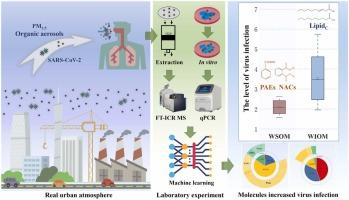当前位置:
X-MOL 学术
›
J. Hazard. Mater.
›
论文详情
Our official English website, www.x-mol.net, welcomes your
feedback! (Note: you will need to create a separate account there.)
Molecular Characteristics of Organic Matters in PM2.5 Associated with Upregulation of Respiratory Virus Infection in Vitro
Journal of Hazardous Materials ( IF 12.2 ) Pub Date : 2024-11-19 , DOI: 10.1016/j.jhazmat.2024.136583 Juying Lin, Wei Sun, Shuyi Peng, Yaohao Hu, Guohua Zhang, Wei Song, Bin Jiang, Yuhong Liao, Chenglei Pei, Jinpu Zhang, Jianwei Dai, Xinming Wang, Ping’an Peng, Xinhui Bi
Journal of Hazardous Materials ( IF 12.2 ) Pub Date : 2024-11-19 , DOI: 10.1016/j.jhazmat.2024.136583 Juying Lin, Wei Sun, Shuyi Peng, Yaohao Hu, Guohua Zhang, Wei Song, Bin Jiang, Yuhong Liao, Chenglei Pei, Jinpu Zhang, Jianwei Dai, Xinming Wang, Ping’an Peng, Xinhui Bi

|
The extent to which organic matters (OM) in PM2.5 affect virus infections and the key organic molecules involved in this process remain unclear. Herein, this study utilized ultra-high resolution mass spectrometry coupled with in vitro experiments to identify the organic molecules associated with respiratory virus infection for the first time. Water-soluble organic matters (WSOM) and water-insoluble organic matters (WIOM) were separated from PM2.5 samples collected at the urban area of Guangzhou, China. Their molecular compositions were analyzed using Fourier transform ion cyclotron resonance mass spectrometry. Subsequently, in vitro experiments were conducted to explore the impact of WSOM and WIOM exposure on the severe acute respiratory syndrome coronavirus 2 (SARS-CoV-2) pseudo-virus infection in A549 cells. Results revealed that WSOM and WIOM respectively promoted 1.7 to 2.1-fold and 1.9 to 3.5-fold upregulation of SARS-CoV-2 pseudo-virus infection in a concentration-dependent manner (at 25 to 100 μg mL-1) compared to the virus-only control group. Partial least squares model analysis indicated that the increased virus infection was likely related to phthalate ester and nitro-aromatic molecules in WSOM, as well as LipidC molecules with aliphatic and olefinic structures in WIOM. Interestingly, the molecules responsible for upregulating SARS-CoV-2 receptor angiotensin-converting enzyme 2 (ACE2) expression and virus infection differed. Thus, it was concluded that ACE2 upregulation alone may not fully elucidate the mechanisms underlying increased susceptibility to virus infection. The findings highlight the critical importance of aromatic and lipid molecules found in OM in relation to respiratory virus infection.
更新日期:2024-11-19


















































 京公网安备 11010802027423号
京公网安备 11010802027423号